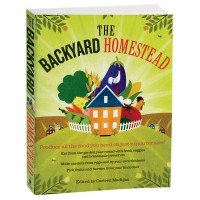
Grow Your Own Food
"This year we have attempted to grow as much of our own food as possible in the city. In our society growing food yourself has become the most radical of acts.
It is truly the only effective protest, one that can - and will - overturn the corporate powers that be."
Path to Freedom - The Original Modern Urban Homestead
Tremendous progress achieved by the trucking, frozen food, and food processing industry is getting fruits and vegetables to the market as close to fresh picked as possible. Foods from the U.S., namely California, Florida, Arizona are available throughout the entire nation during winter months when this production over the rest of the country is at a standstill.
Even with the crusade by industry and local groups to achieve the quality of garden and the progress made in this direction, I have yet to taste the equal of home grown food. Eating a strawberry within an hour of it being alive on the plant is only attainable one way, picking it off the plant yourself. The only way to achieve this quality is to grow your own food. The health and taste of food grown in healthy organic soil is a condition that even organic growers, never mind the commercial industry cannot ever hope to attain.
A home food grower with even the tiniest bit of growing space can, if selectively planted yield a surprising amount of food. In fact a gardening space of 15x20 will take care of much of the vegetable needs of a family of four. The phrase "selectively" planted means avoiding sprawling plants like vine squashes and melons. It is also unlikely that corn could be accommodated.
Small space consumers like carrots, beets, lettuce, bush beans, onions, turnips, radish, kohlrabi, spinach, and bush summer squash all recommend them to a limited garden space. Square foot and other "intensive" gardening methods help obtain maximum yields. Vertical gardening is another method that can be employed to conserve space.
To gain full use of limited space plant "early" or quickly maturing vegetables like radishes, lettuce, turnips, beets, and the quick yielding bush bean will, after harvesting, permit second plantings of additional veggies for a late fall harvest.
Growing Vegetables for Food
Corn
Three Sisters
A time tested trio used by the American Indians.
Cruciferous (Cabbage and Mustard Family)
including Broccoli, Kale, and hmmm... Brussell Sprouts!
Cruciferous Vegetables and Winter Gardening
Cucumbers
Growing Cucumbers
Learn How to Plant, Pick and Preserve This Crisp Vining Squash
Greens
Legumes (Peas, Green Beans, Lima Beans, etc)
How to Grow Green Beans
The bean is a tender, warm season vegetable that ranks second to tomato in popularity in home gardens.
- Alliums
Growing healthy onions, garlic, chives, shallots, leeks, and scallions. Find solutions to problems with growing, pests and disease.
- How to Organically Grow Beets
From top to bottom, beets are a nutritious, delicious plant to eat.
- How to Grow Carrots
- From Whence Came the Carrot?
Where do you think carrots originated? We're not talking about the wild
carrots that only a rabbit might consider delectable. We're talking about
the nice thick tuber, orange (now) and full of Vitamin A.
- Horseradish
The name "horseradish" is thought to have come from an English adaptation of its German name.
- What To Store In A Root Cellar
Ideal Storage Temperatures, Relative Humidity, and Average Storage Life
- How to Grow Garlic
When you go to the grocery, you're most apt to find only "generic" garlic. But go to a farmer's market in the summer and fall, and you'll likely find at least
a few of the dozens of garlic varieties available. Why take a chance on finding some of these when it is incredibly easy to grow your own?
- How to Store Root Crops
Have your fall garden of root crops mature as late as possible by planting as
late as possible. Cold weather sweetens the roots and you'll be putting the freshest
produce into a cool root cellar, garage or back porch.
- Using Root Cellars to Preserve Vegetables
Tomatoes
Winter Gardening
Many Winter Vegetables Can Be Grown In Containers
The satisfaction of growing fresh vegetables is undeniable, but many gardeners do not have a suitable in-ground location to grow them.

More Vegetable Gardening Articles
I went to the woods because I wished to live deliberately,
to front only the essential facts of life, and see if I could not learn what
it had to teach, and not, when I came to die, discover that I had not lived.
I wanted to live deep and suck all the marrow of life....
-- Henry David Thoreau, author of Walden


Build Your Own!

Learn how to create your own geodesic dome green house and have your own 'Organic Food Factory' providing you and your family with incredible food, year round, even in the dead of winter!
Click Here!

What's New?
Discover how to easily build an attractive and affordable greenhouse that will grow anything in any conditions. Also, building your own greenhouse just makes economical sense. You can build a greenhouse at just a fraction of the cost of buying a pre-built one. Most pre-built greenhouse you buy need to be assembled anyway, you are really just paying hugely inflated prices for the material.
Click Here!
Book of the Month


Grow the vegetables and fruits your family loves; keep bees, raise chickens, goats, or even a cow!
The Backyard Homestead shows you how it's done. And when the harvest is in, you'll learn how to cook, preserve,
cure, brew, or pickle the fruits of your labor.







 Learn how to create your own geodesic dome green house and have your own 'Organic Food Factory' providing you and your family with incredible food, year round, even in the dead of winter!
Click Here!
Learn how to create your own geodesic dome green house and have your own 'Organic Food Factory' providing you and your family with incredible food, year round, even in the dead of winter!
Click Here!
